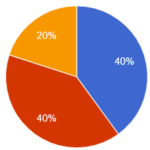UCAT Quantitative Reasoning Strategies
1. Understand the Question Types
The Quantitative Reasoning section of the UCAT typically includes questions that test your ability to:
- Perform numerical calculations (e.g., arithmetic, percentages, fractions).
- Interpret data presented in tables, graphs, and charts.
- Solve problems involving algebraic equations, geometry, and basic statistics.
Familiarize yourself with each type of question and the skills required to solve them efficiently.
2. Regular Practice
Regular practice is crucial to improving your speed and accuracy. Use official UCAT practice materials, past papers, and online resources to simulate exam conditions. Aim to complete timed practice tests to gauge your progress.
3. Master Key Mathematical Concepts
Focus on understanding and applying fundamental mathematical concepts:
- Arithmetic: Operations involving numbers, fractions, decimals, and percentages.
- Algebra: Solving equations and inequalities, understanding functions and sequences.
- Geometry: Properties of shapes, angles, area, and volume calculations.
- Statistics: Basic concepts such as mean, median, mode, and probability.
Ensure you know relevant formulas and practice applying them under time pressure.
4. Develop Mental Math Skills
Given the time constraints of the UCAT, practice mental math techniques to perform calculations quickly without relying heavily on a calculator. This includes techniques for rapid addition, subtraction, multiplication, and division.
5. Enhance Data Interpretation Abilities
A significant portion of the Quantitative Reasoning section involves interpreting data from graphs, tables, and charts. Practice extracting relevant information quickly and accurately, and identifying trends or patterns presented in visual formats.
6. Time Management
The UCAT Quantitative Reasoning section is timed, so effective time management is essential. Develop a strategy for allocating time to each question based on its difficulty and ensure you stick to it during practice sessions. Learn to recognize when to move on from a challenging question to maximize your overall score.
7. Review and Learn from Mistakes
After each practice session or mock test, review your answers to identify any patterns of errors or weaknesses. Focus on understanding why you made mistakes and work on improving those areas through targeted practice.
8. Stay Calm and Focused During the Exam
On exam day, maintain a calm and focused mindset to avoid making careless errors due to nerves or time pressure. Take deep breaths, read each question carefully, and apply the strategies you’ve practiced during your preparation.
By systematically working through these strategies and dedicating consistent effort to practice, you can significantly enhance your performance on the UCAT Quantitative Reasoning subtest.
Quantitative Reasoning (QR) is the ability to understand and manipulate numerical and statistical information to solve problems and make informed decisions. In the context of medical practice, QR skills are crucial for several reasons:
-
Data Interpretation: Doctors frequently encounter numerical data in the form of lab results, imaging studies, patient vital signs, and research findings. QR skills allow them to accurately interpret this data to diagnose conditions, monitor patient progress, and make treatment decisions.
-
Evidence-Based Medicine: Medical practice increasingly relies on evidence-based approaches, which involve understanding and evaluating statistical data from clinical trials and research studies. QR skills are essential for critically appraising this information and applying it to patient care.
-
Medical Research: Doctors often engage in research or collaborate with researchers to advance medical knowledge. Quantitative skills are necessary for designing studies, analyzing data, and interpreting statistical findings accurately.
-
Patient Safety and Quality Improvement: Understanding numerical data helps doctors assess risks, evaluate treatment outcomes, and implement quality improvement initiatives to enhance patient safety and care effectiveness.
-
Effective Communication: QR skills enable doctors to communicate complex medical information clearly and accurately to patients, colleagues, and other healthcare professionals. This includes explaining risks and benefits of treatments and interventions based on statistical evidence.
In summary, Quantitative Reasoning is integral to medical practice as it facilitates evidence-based decision-making, ensures patient safety, supports medical research, and enhances communication in healthcare settings. Doctors with strong QR skills are better equipped to provide high-quality care and contribute to advancements in medicine.
-
Strategies for Success
- Practice Basic Math Skills: Ensure a strong foundation in arithmetic, percentages, ratios, and algebra.
- Familiarize with Data Interpretation: Practice analyzing and interpreting data from different formats such as tables, charts, and graphs.
- Develop Problem-Solving Techniques: Learn and practice different strategies for tackling word problems and complex scenarios.
- Use a Calculator Efficiently: Become proficient with the on-screen calculator provided during the test.
- Manage Time Wisely: Allocate time appropriately to ensure all questions are attempted within the time limit
- Basic arithmetic
- Proportionality
- Percentage and percentage changes
- Fractions and decimals
- Ratios
- Speed, distance and time
- Money, income tax, VAT, Tariffs & exchanges
- Geometry: area and volume
- Population densities
- Average and ranges: means, median and mode
- Schedule and time
- Rates
Quantitative Reasoning
- Tax calculations:
- Spot the bracket that the income fits in and calculate how much of the income is within the bracket(s).
- Work out the amount, using the given percentages.
- Add the tax of each bracket that the income falls into.
Conversion
1mi = 1.6km
1ft = 12 in
1kg = 2.2 pounds
1cm = 0.4 in
Equations
Area of a circle =
Diameter of a circle =
Volume of a circle =
Midpoint = ( )/2
- Total price of share = % shares x Total shares x Price of shares
- How to work out time zones
|
Destination |
Departure time |
Landing time |
Time difference (hrs) |
|
San Francisco |
10:25 |
13:35 |
-8hours |
|
Toronto |
12:05 |
14:45 |
-5hours |
|
Tokyo |
15:45 |
11:15(+1) |
-8hours |
|
Johannesburg |
19:05 |
07:05(+1) |
-1hour |
|
Bangkok |
21:30 |
15:00(+1) |
-5hours |
Time zone, percentage, bar chart, ratios, tax, reverse tax, income, table, pie chart, salary, conversions
- Population density = population / area
- Percentage increase/decrease = (New-old)/old
- Km/h = m/s
Patterns
Tables – grades, exam, medicine, percentage, company, clothes, tickets, zoo, hot drinks.
Volume – dimensions, bottles, glass, cups
Graph – runners, speed, race







